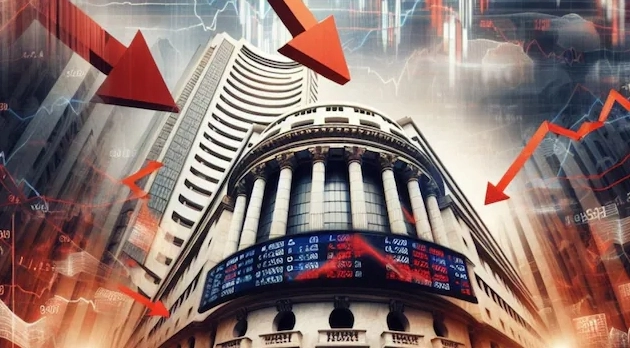
Stock Market Crash Today: The domestic share market on Monday started the week with a massive sell-off in the opening trade with the NSE Nifty and BSE Sensex opening by over 3.5 per cent down to hit 10-month lows on April 7. The bloodbath in the domestic market comes even as global markets are witnessing an even worse crash, with Tokyo’s Nikkei 225 index losing nearly 8% shortly after the market opened, Australia’s S&P/ASX 200 tumbling more than 6%, and South Korea’s Kospi down by 4.4%.
The BSE Sensex on Monday crashed 3,939.68 points to 71,425.01 in the opening trade, the NSE Nifty tumbled 1,160.8 points to 21,743.65.
Why Is Sensex Down Today?
Tariff War: The biggest reason for the decline in the stock market is the ongoing tariff war after US President Donald Trump’s imposition of ‘reciprocal tariffs’ across the world on all almost goods imports into the US. Following this, China has announced a retaliatory tariff of 34 per cent on the US, deepening the global trade war. It has triggered a massive sell of in the global equities.
“Globally, markets are going through heightened volatility caused by extreme uncertainty. No one has a clue about how this turbulence caused by Trump tariffs will evolve," said V K Vijayakumar, chief investment strategist of Geojit Financial Services.
US Recession Fear: Following the tariff imposition, analysts expect the US to go into recession amid rising inflation and falling growth. Goldman Sachs has increased the US recession probability to 45% (up from 35%). It said if most of the April 9 tariffs do take effect, then “we expect to change our forecast to a recession.
All sectors were deep in the red, with Nifty Metal taking the steepest hit, tumbling over 6 percent. Nifty IT and Nifty Auto also suffered significant losses, declining in the range of 4 to 5 percent. Meanwhile, India VIX — the volatility index that gauges near-term market sentiment — spiked more than 55 percent, climbing above the 21 mark and indicating heightened fear among investors.
The broader markets were not spared either, with both the midcap and smallcap indices shedding over 3 percent each.
What Analysts Say
On the Nifty, ICICI Securities in its note on Monday said, “Trade war concerns kept risk assets under pressure across the globe with India being no exception. Nifty as well midcap and small cap indices lost more than 2% last week amid ongoing uncertainty. Considering weak global markets and resurfaced selling pressure from FIIs, we should avoid buying till Nifty is not moving above 22800 levels once again. From the support perspective, Feb lows near 22000 should provide immediate support to the indices."
Vijayakumar said that waiting and watching would be the best strategy in this turbulent phase of the market. There are a few things that investors should keep in mind. One, the irrational Trump tariffs will not continue for long. Two, India is relatively better placed since India’s exports to the US as a percentage of GDP is only around 2 percent, and therefore, the impact on India’s growth will not be significant. Three, India is negotiating a Bilateral Trade Agreement with the U.S., and this is likely to be successful, resulting in lower tariffs for India.
“Domestic consumption themes like financials, aviation, hotels, select autos, cement, defence and digital platform companies are likely to come out relatively unscathed from the ongoing crisis. Trump is unlikely to impose tariffs on pharmaceuticals since he is on the back foot now and, therefore, this segment is likely to show resilience," he added.
Technical View
Anand James, chief market strategist of Geojit Investments Limited, said, All through last week, though 21800 kept surfacing in our estimations, we had refrained from seeing such a collapse as a likely event, expecting 22730-650-522 support to hold. But, Friday’s panic sell off has weakened this construct of expecting support to stay relevant, as a gapped down opening is likely to scythe through such levels."
But, that would also mean that we might be testing 2 standard deviations below mean, taking just under 10 days to travel from +2 to -2 standard deviation. Such a scenario would improve the odds of a close back above 22165, or 22522 today in a best case scenario, he added.
Asian Markets
Japan’s share benchmark nosedived on Monday after the meltdown on Friday on Wall Street over U.S. President Donald Trump’s tariff hikes. Tokyo’s Nikkei 225 index lost nearly 8% shortly after the market opened, and Australia’s S&P/ASX 200 tumbled more than 6%.
South Korea’s Kospi lost 4.4%.
US futures signaled further weakness. The future for the S&P 500 lost 4.2% while that for the Dow Jones Industrial Average shed 3.5%. The Nasdaq lost 5.3%.
On Friday, Wall Street’s worst crisis since COVID-19 slammed into a higher gear. The S&P 500 plummeted 6%, and the Dow plunged 5.5%. The Nasdaq composite dropped 5.8%.